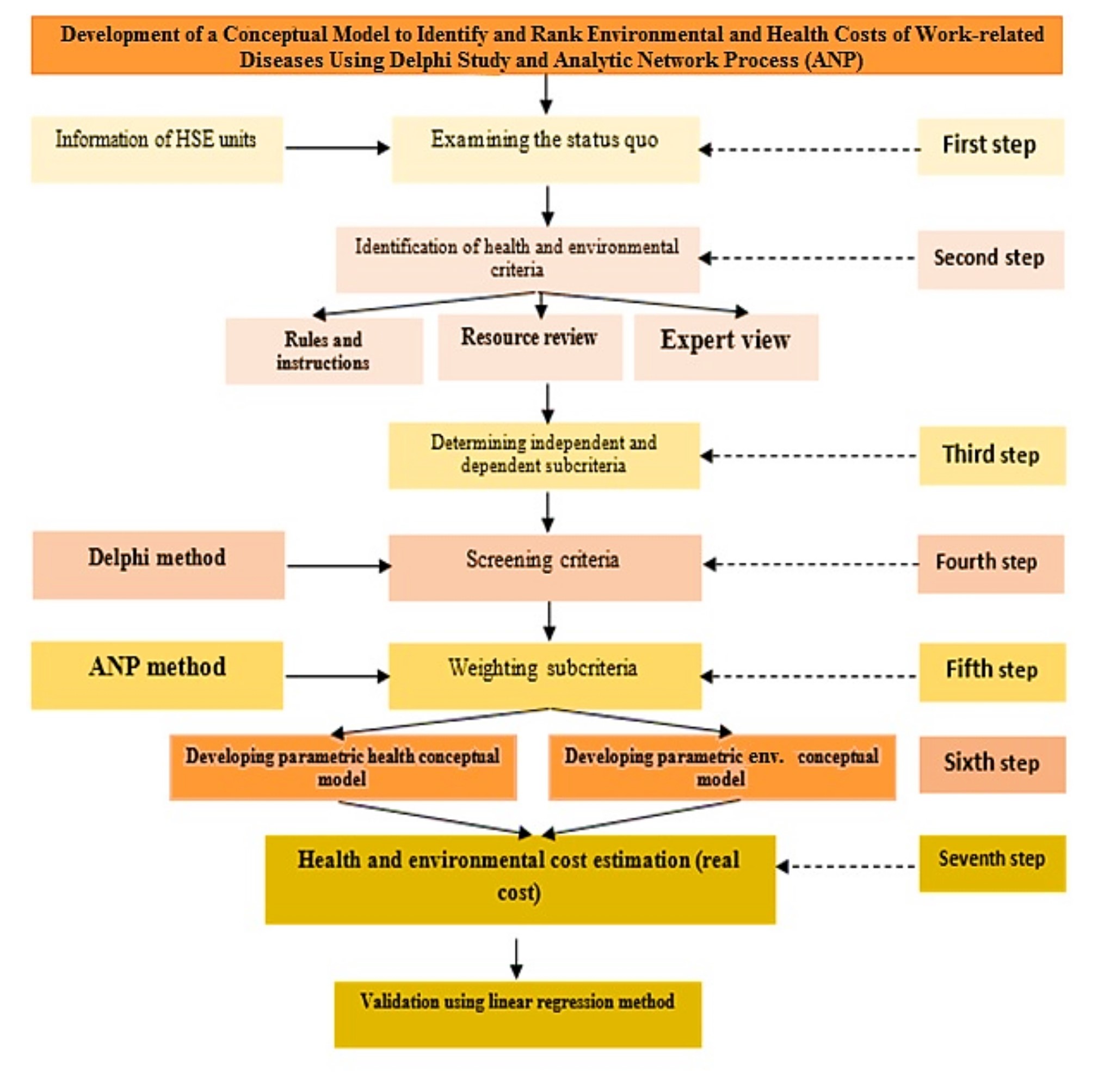Volume 14, Issue 2 (6-2024)
J Health Saf Work 2024, 14(2): 291-315 |
Back to browse issues page
Download citation:
BibTeX | RIS | EndNote | Medlars | ProCite | Reference Manager | RefWorks
Send citation to:



BibTeX | RIS | EndNote | Medlars | ProCite | Reference Manager | RefWorks
Send citation to:
Ghassemi Jondabeh S, Dana T, Robati M, Abedi Z, Golbabaei F. Development of a Conceptual Model to Identify and Rank Environmental and Health Costs of Work-Related Diseases Using Delphi Study and Analytic Network Process. J Health Saf Work 2024; 14 (2) :291-315
URL: http://jhsw.tums.ac.ir/article-1-6984-en.html
URL: http://jhsw.tums.ac.ir/article-1-6984-en.html
1- Department of Environmental Sciences, Faculty of Natural Resources and Environment, Islamic Azad University, Science and Research Branch, Tehran, Iran
2- Department of Environmental Sciences, Faculty of Natural Resources and Environment, Islamic Azad University, Science and Research Branch, Tehran, Iran ,t-dana@srbiau.ac.ir
3- Department of Occupational Health Engineering, School of Public Health, Tehran University of Medical Sciences, Tehran, Iran
2- Department of Environmental Sciences, Faculty of Natural Resources and Environment, Islamic Azad University, Science and Research Branch, Tehran, Iran ,
3- Department of Occupational Health Engineering, School of Public Health, Tehran University of Medical Sciences, Tehran, Iran
Abstract: (686 Views)
Introduction: Improving health and the environment is one of the components of development, social welfare, and economic growth. Another influential factor in increasing health costs and reducing social welfare is work-related accidents and diseases, which impose high costs on individuals, industries, and the national economies of countries. Therefore, using multi-criteria decision-making methods, the present study provided a conceptual model to identify and rank work-related diseases’ environmental and health costs.
Material and Methods: The present study was conducted in 2023. A classification model for the economic evaluation of environmental and health costs of occupational diseases was developed to achieve the study’s aim. In the current research, the Delphi method was used to identify health and environmental criteria, and the Analytic Network Process (ANP) was used to weight the sub-criteria. Finally, the cost of health and the environment was estimated based on the available information. Naft Tehran Hospital (NSHT) was also selected as a case study site.
Results: The results showed that the drug and medical equipment cost factor, with a weight of 0.312 in the treatment sector, and the particular and infectious waste cost factor, with a weight of 0.085, were the most critical factors in the economic evaluation. Also, the parametric model results showed that 99.84% of the total costs are related to health costs, and 0.16% are related to environmental costs. In general, the results of this research showed that 61.3% of the costs of the health sector are related to the two sectors of medicine and medical equipment and the cost of service personnel, and 91.7% of the costs of the environmental sector are related to wastewater treatment and the cost of electricity consumption.
Conclusion: This study presented a semi-quantitative model to estimate health and environmental costs caused by occupational diseases. The results can create a novel scientific insight into implementing control measures using the optimal point of cost-benefit parameters. Implementing this integrated model can be a practical and effective step in allocating resources and prioritizing interventions.
Material and Methods: The present study was conducted in 2023. A classification model for the economic evaluation of environmental and health costs of occupational diseases was developed to achieve the study’s aim. In the current research, the Delphi method was used to identify health and environmental criteria, and the Analytic Network Process (ANP) was used to weight the sub-criteria. Finally, the cost of health and the environment was estimated based on the available information. Naft Tehran Hospital (NSHT) was also selected as a case study site.
Results: The results showed that the drug and medical equipment cost factor, with a weight of 0.312 in the treatment sector, and the particular and infectious waste cost factor, with a weight of 0.085, were the most critical factors in the economic evaluation. Also, the parametric model results showed that 99.84% of the total costs are related to health costs, and 0.16% are related to environmental costs. In general, the results of this research showed that 61.3% of the costs of the health sector are related to the two sectors of medicine and medical equipment and the cost of service personnel, and 91.7% of the costs of the environmental sector are related to wastewater treatment and the cost of electricity consumption.
Conclusion: This study presented a semi-quantitative model to estimate health and environmental costs caused by occupational diseases. The results can create a novel scientific insight into implementing control measures using the optimal point of cost-benefit parameters. Implementing this integrated model can be a practical and effective step in allocating resources and prioritizing interventions.
Type of Study: Research |
Received: 2024/07/2 | Accepted: 2024/06/30 | Published: 2024/06/30
Received: 2024/07/2 | Accepted: 2024/06/30 | Published: 2024/06/30
Send email to the article author
| Rights and permissions | |
 |
This work is licensed under a Creative Commons Attribution-NonCommercial 4.0 International License. |







